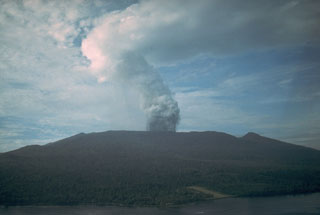Report on Karkar (Papua New Guinea) — 25 November-1 December 2009
Smithsonian Institution / US Geological Survey
Weekly Volcanic Activity Report, 25 November-1 December 2009
Managing Editor: Sally Sennert.
Please cite this report as:
Global Volcanism Program, 2009. Report on Karkar (Papua New Guinea) (Sennert, S, ed.). Weekly Volcanic Activity Report, 25 November-1 December 2009. Smithsonian Institution and US Geological Survey.
Karkar
Papua New Guinea
4.647°S, 145.976°E; summit elev. 1839 m
All times are local (unless otherwise noted)
Based on analyses of satellite imagery, the Darwin VAAC reported that an eruption from Karkar on 25 November produced a plume that rose to an altitude of 13.7 km (45,000 ft) a.s.l. The report also stated that ash had merged with a thunderstorm cloud and had become unidentifiable. Another ash plume identified on 26 November rose to an altitude of 9.1 km (30,000 ft) a.s.l. Confirmation of ash emissions was not available from RVO at the time of the posting of this report. [Note: Further analyses revealed that an eruption had not occurred. Additional information received by RVO indicated dead vegetation S of the active crater (similar observations were made in 2007) and a few new "holes" in the crater area.]
Geological Summary. Karkar is a 19 x 25 km forest-covered island that is truncated by two nested summit calderas. The 5.5 km outer caldera was formed during one or more eruptions, the last of which occurred 9,000 years ago. The steep-walled 300-m-deep, 3.2 km diameter, inner caldera was formed sometime between 1,500 and 800 years ago. Cones are present on the N and S flanks of this basaltic-to-andesitic volcano; a linear array of small cones extends from the northern rim of the outer caldera nearly to the coast. Recorded eruptions date back to 1643 from Bagiai, a pyroclastic cone constructed within the inner caldera, the floor of which is covered by young, mostly unvegetated andesitic lava flows.

